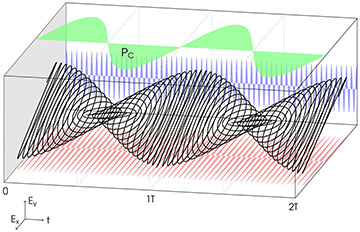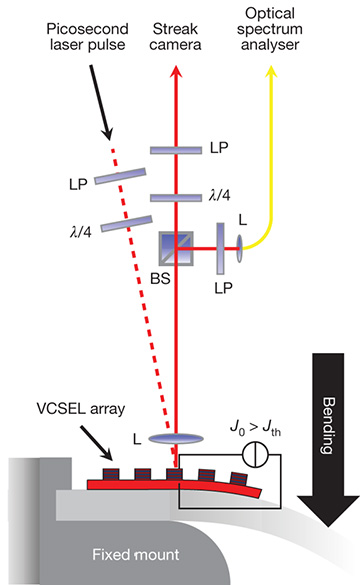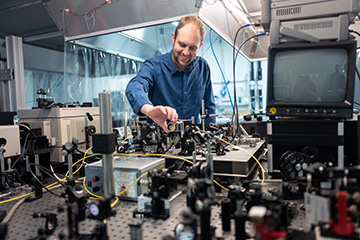![]()
A view of the German-U.S. team’s spin laser device, which the researchers say could eventually improve data transfer rates in some communications settings by an order of magnitude or more. [Image: RUB, Kramer]
In the relentless drive for ever-greater internet bandwidth, one potential bottleneck lies in the current-driven, intensity-modulated vertical-cavity surface-emitting lasers (VCSELs) that handle short-run, high-speed optical interconnects in data centers. While these semiconductor lasers have enabled vast increases in data transfer rates, their reliance on light-intensity modulation eventually imposes a cap—and requires increasing amounts of electrical energy as that limit is approached.
Researchers at German and U.S. institutions have now come up with a method that could get beyond that cap—a technique that takes a page from the emerging area of spin electronics, or spintronics (Nature, doi: 10.1038/s41586-019-1073-y). Specifically, the research team has found that, by injecting spin-carrying charges and a circularly polarized laser pump pulse, and by mechanically bending the VCSEL semiconductor, it can move the system to one that carries data encoded in polarization rather than intensity.
That switch in data carrier, according to the researchers, can dramatically cut the energy cost—and can boost the laser’s information-carrying bandwidth by nearly an order of magnitude above the best conventional intensity-modulated VCSELs. The team believes that the technique, which has the added bonus of working at room temperature, offers a possible approach to overcoming “the bandwidth bottleneck in short-haul optical interconnects.”
Intensity modulation’s drawbacks
The problem addressed by research team, which included scientists at Ruhr-Universität Bochum and Ulm University, Germany, and the State University of New York, Buffalo, USA, lies in how data is encoded onto the laser light from the electrically pumped VCSEL. The encoding specifically relies on modulation of the light’s intensity. Because of the dynamics of the coupling between the electric charge carriers and the photons in the laser semiconductor, however, and because of thermal effects, this intensity encoding effectively limits the modulation bandwidth—basically the rate at which new data can be encoded onto the beam—to no more than around 35 GHz (35 billion times per second).
While that sounds like a brisk pace, the researchers note that the cap will impose a significant bottleneck as the world’s appetite for internet data continues to expand. Moreover, because the lasers are electrically pumped, pushing them close to this bandwidth limit imposes a significant energy cost. “Unless we upgrade the technology soon,” team leader Martin Hoffmann of Bochum noted in a press release accompanying the research, “data transfer and the internet are going to consume more energy than we are currently producing on Earth.”
Spintronics to the rescue?
This quandary has spurred a search for ways to enhance the laser’s modulation bandwidth, including tweaks to materials and laser mirror design, and even new types of coupled-cavity VCSEL arrays or photonic-crystal-based systems. But while some of these approaches have managed to push modulation frequencies above 100 GHz, they’ve required chilly, cryogenic temperatures to do so.

An emission whose electric field has a different frequency in the horizontal and vertical polarization directions can give rise to circular polarization that oscillates at a “beat” frequency related to the difference between the two polarization components. That polarization oscillation could serve as an ultra-high-speed data carrier in optical communications. [Image: RUB, Chair of Photonics and Terahertz Technology]
Instead of looking at changes to materials or VCSEL design, the German-U.S. team focused on speeding up data transfer by switching to a different system of modulation—one that relies on changes in the light’s polarization rather than its intensity. To get there, the researchers zeroed in on concepts drawn from the emerging area of spintronics.
Spintronics is preoccupied with making electronic devices that leverage the electron’s quantum-mechanical spin, and the associated magnetic moment, in addition to its charge. The scheme opens a degree of freedom that, it’s hoped, can substantially boost opportunities for device efficiency and information storage capacity. In the photonics realm, the spintronic approach has led to the development of so-called spin lasers, in which spin-polarized charge carriers are injected into the laser semiconductor to exploit the potential coupling between electron spin and photon polarization.
VCSELs on a bender
The team behind the new research wanted to see whether that coupling could be put to work in a conventional semiconductor laser to allow faster data transfer rates, relying on oscillations in polarization rather than intensity. To do so, they needed a VCSEL with high birefringence—that is, one whose refractive index differs in the x and y directions.
That anisotropy allows the creation of linearly polarized VCSEL beams with different frequencies in the x and y polarization components. Because circular polarization is essentially a superposition of the linear polarization components, those frequency differences would result in a circular or spin polarization that would oscillate between a right- and left-handed sense—at a beat rate tied to the difference frequency between the two linear-polarization components.

The team’s setup used a bent array of semiconductor lasers to increase birefringence, and a combination of electrical and optical pumping. The results were read using a streak camera. [Image: Reprinted by permission from Springer Nature: M. Lindemann et al., Nature, doi: 10.1038/s41586-019-1073-y, © 2019]
The team found that it could get to the right kind of birefringence simply by mechanically bending a conventional VCSEL array. As an extra bonus, the researchers were able to adjust the amount of birefringence, and thus the frequency of the polarization switching in the VCSEL emission, by tweaking the amount of bending in the semiconductor.
Tenfold rate increase
The researchers took such a bent array of conventional AlGaAs-based, 850-nm VCSELs, and set up a hybrid pumping scheme—injection of spin-unpolarized charge carriers via direct current, coupled with picosecond, circularly polarized laser pulses. The hybrid pumping resonantly excites spin-polarized carriers in the semiconductor’s active region. That, in turn, induces a circularly polarized emission from the VCSEL, with the polarization oscillating at a frequency determined by the bending-induced birefringence.
Measuring the output with a streak camera, the team was able to observe circular-polarization oscillations in the device at a frequency greater than 200 GHz—“an order of magnitude faster than intensity dynamics for the same device,” according to the study. And the boost in speed took place in room-temperature rather than cryogenic operation, an important advantage for the real world.
No theoretical speed limit?
While the researchers measured the rate of polarization oscillation, they didn’t actually attempt the transfer of polarization-modulated information using the device—though they did undertake numerical experiments showing that polarization-modulated data transfer is possible at these blistering 200-GHz-plus rates.

Lead author Markus Lindemann at the optical bench. [Image: RUB, Kramer]
Indeed, the team believes that the basic design it’s demonstrated could be pushed even faster through other techniques—such as building the lasers using 2-D materials, which can support very large strains and very high birefringence, and thus could produce far brisker polarization oscillations. “We have experimentally demonstrated that oscillation at 200 gigahertz is possible,” Hofmann said. “But we don’t know how much faster it can become, as we haven’t found a theoretical limit yet.”
The team concludes that its results “overcome the key speed limitations of conventional directly modulated lasers and offer a prospect for the next generation of low-energy ultrafast optical communication.”
